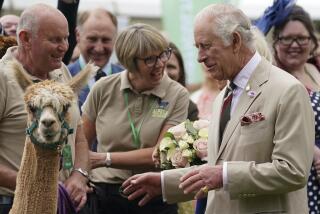Queen Elizabeth, Charles to Pay Taxes at Top Rate : Britain: The monarch will not be subject to ordinary inheritance taxes on assets owned as sovereign, such as castles, art and crown jewels.
- Share via
LONDON — Queen Elizabeth II and her son and heir, the Prince of Wales, will begin paying the top tax rate on their personal income in April, Prime Minister John Major announced in Parliament on Thursday.
The agreement was revealed after almost a year of negotiations among the Inland Revenue Department, the British Treasury and the royal household--in the face of popular pressure that the queen should pay taxes.
However, her fortune will not be subject to ordinary inheritance taxes on assets owned as the sovereign--such as her castles, palaces, art collection and crown jewels.
“I believe that is necessary to protect the independence of the monarchy,” said Major, who noted that, otherwise, the kingdom could be “salami sliced,” reducing the royal assets over the generations.
But he said the inheritance tax “should apply to all bequests or gifts by the sovereign, other than to transfers of assets from one sovereign to his or her successor.”
Major also told members of Parliament that the queen had agreed to cut the number of members of the Royal Family funded by the taxpayers, leaving on the Civil List, the government-supplied allowance, only herself, her husband, the Duke of Edinburgh and the Queen Mother.
Further, Prince Charles will pay taxes at the ordinary income rate from his Duchy of Cornwall, which has massive real estate holdings, replacing the voluntary 25% he now pays.
A charitable trust will be set up to administer the queen’s large art collection, Major said, funded in part by public admission charges.
After the prime minister’s announcement, members of the royal household headed by the Lord Chamberlain, Lord Airlie, held a rare media briefing. Airlie said the new taxes would place a “considerable additional burden” on the queen’s finances.
In explaining the queen’s decision to subject her income to taxation, Airlie said, “It is only by moving with the times, not too fast and not too slow, that the institution itself can continue to make its essential contribution to national life.”
Airlie said the size of the queen’s personal fortune--variously estimated from $135 million to more than $9 billion--was “grossly exaggerated.”
But he did not give any estimate of her assets, either public holdings or private investment portfolio, so even with her taxes at the highest 40% rate, it will still not be known how much she will pay.
In his statement to the House of Commons, Major said the Royal Family’s tax figures would remain confidential--as is the case with every other taxpayer.
But Phillip Hall, author of a book on royal finances, estimated that the queen had personal tax liabilities that could produce a $20-million annual payment.
Queen Victoria paid income tax when it was first introduced in the last century. But King George V negotiated various exemptions in 1910, while his son, George VI, Elizabeth’s father, stopped paying any income tax in the 1930s.
The queen’s decision to pay taxes was generally greeted favorably.
Lord St. John of Fawsley, former Conservative Cabinet minister and constitutional expert, said it was “one of the great acts of statesmanship of her reign. Only the most curmudgeonly will raise objections to a settlement as comprehensive as it is magnanimous.”
A Guide to the Royal Riches
The secrecy and confusion surrounding the queen’s fortune is partly due to the problem of working out which palaces, jewels and pictures belong to her and which she holds in safekeeping for the nation. Some facts about the fortune: Estimates of her wealth: $135 million to $9 billion. When she’ll begin paying taxes: April 6 Tax obligation: Owed on income and capital gains Tax bracket: The top rate of 40% Tax break: Not required to pay inheritance tax
QUEEN’S PRIVATE FINANCES The queen’s private wealth is defined as personal assets such as shares and treasures that she could sell if she wished. They include: 1. The royal palaces of Balmoral and Sandringham, plus the Duchy of Lancaster estate and the Duchy of Cornwall. 2. A large share portfolio and some stud farms that provide homebred stock for her stable of racehorses. 3. The royal art collection, including more than 5,000 paintings, is the queen’s private property, but it is technically held in trust by her for the nation. Its maintenance will now pass to a new charitable trust, funded from income generated by admissions charges.
Source: Times wire reports
More to Read
Sign up for Essential California
The most important California stories and recommendations in your inbox every morning.
You may occasionally receive promotional content from the Los Angeles Times.













